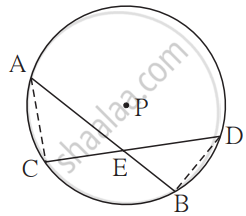Advertisements
Advertisements
प्रश्न

Given:
Chords AB and CD of a circle with centre P intersect at point E.
To prove:
AE × EB = CE × ED
Construction:
Draw seg AC and seg BD.
Fill in the blanks and complete the proof.
Proof:
In Δ CAE and Δ BDE,
∠AEC ≅ ∠DEB ...`square`
`square` ≅ ∠BDE ...(angles inscribed in the same arc)
∴ ΔCAE ~ ΔBDE ...`square`
∴ `square/ ("DE") = ("CE")/square` ...`square`
∴ AE × EB = CE × ED.
उत्तर
Given that chords AB and CD of a circle intersect at point E, we need to prove:
AE × EB = CE × ED
In △CAE and △BDE:
- ∠AEC ≅ ∠DEB → Vertically opposite angles.
- ∠CAE ≅ ∠BDE → Angles inscribed in the same arc.
△CAE ∼ △BDE
Thus, corresponding sides are proportional:
`(AE)/(DE) = (CE)/(EB)`
Cross multiplying:
AE × EB = CE × ED
- ∠AEC ≅ ∠DEB → Vertically opposite angles.
- ∠CAE ≅ ∠BDE → Angles inscribed in the same arc.
- △CAE ∼ △BDE → By AA similarity.
- `(AE)/(DE) = (CE)/(EB)` → By property of similar triangles.
- AE × EB = CE × ED → By cross multiplication.
APPEARS IN
संबंधित प्रश्न
Write the length of largest chord of a circle with radius 3.2 cm.
In the given figure, m(arc WY) = 44°, m(arc ZX) = 68°, then
(1) Find the measure of ∠ ZTX.
(2) If WT = 4.8, TX = 8.0,
YT = 6.4, find TZ.
(3) If WX = 25, YT = 8,
YZ = 26, find WT.

In the above figure, m(arc DXE) = 105°, m(Arc AYC) = 47°, then find the measure of ∠DBE.

Chords AB and CD of a circle intersect inside the circle at point E. If AE = 4, EB = 10, CE = 8, then find ED.
Four alternative answers for the following question are given. Choose the correct alternative and write its alphabet:
A circle having radius 3 cm, then the length of its largest chord is ______.
